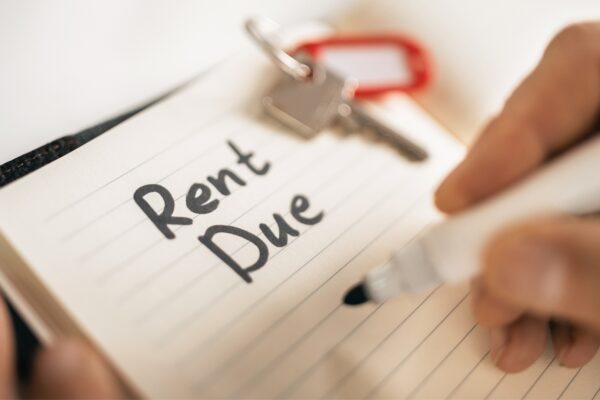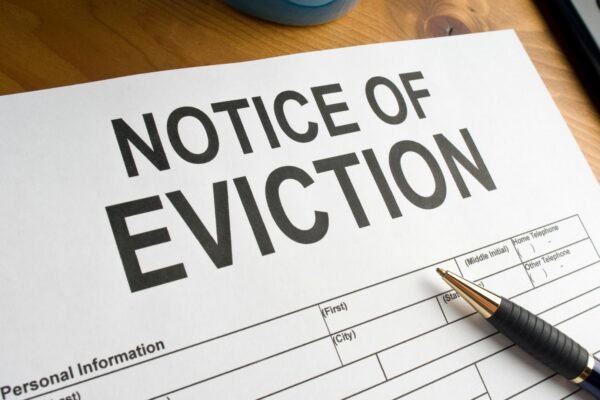During your tenancy, there might come a point when you need to reclaim possession of your property through a Section 8 notice.
Understanding when and how to serve notice as a landlord can be challenging and often stressful.
In this article, we’ll cover all you need to know about Section 8 notices and the reasons they can be issued during an Assured Shorthold Tenancy.
- What is a Section 8 notice?
- When can I serve a Section 8 notice?
- What are the grounds for serving a Section 8 notice?
- How to serve a Section 8 notice
- The Renters’ Rights Bill and Section 8
More than a million properties have been let on OpenRent – why not yours too? Explore Our Packages
What is a Section 8 notice?
Section 8 refers to a specific part of the Housing Act 1988. It enables landlords to evict tenants in certain situations.
These include when tenants break their rental agreement by not paying rent or causing disturbances, or when landlords want to change how the property is used, such as for redevelopment or as a holiday let.
A Section 8 notice allows landlords to terminate a tenancy agreement early (for reasons we’ll explore in depth below).
Unlike a Section 21 notice, which can only be served at the end of a tenancy, a Section 8 notice can be issued during an Assured Shorthold Tenancy (i.e., before the contract comes to an end).
When can I serve a Section 8 notice?
A Section 8 notice can be served during the tenancy if there are valid reasons for eviction.
The length of the notice period depends on the timing and specific grounds cited, which can vary significantly.
For example, a landlord might need to provide only two weeks’ notice for serious rent arrears, but two months’ notice for other grounds such as their intention to move back into the property.
Can Section 8 and Section 21 notices be served at the same time?
Yes, landlords can serve both Section 8 and Section 21 notices simultaneously. For example, if a tenant falls two months behind on rent, the landlord may serve a Section 8 notice.
Even if the tenant resolves the rent arrears later on, the landlord might still want to regain possession of the property. Therefore, they can also serve a Section 21 notice after the tenancy ends.
You might also be interested in…
- Guide to the Renters’ Rights Act for Landlords 2025
- 8 Million Users Trust OpenRent to Find and Let Homes 🎉
- What is an HMO? How Do I Convert My Property?
- Pets in Rental Properties: What Every Landlord Should Know
- Joint Tenancy Guide: Understanding Joint and Several Liability
What are the grounds for serving a Section 8 notice?
There are eight ‘Mandatory’ grounds for possession and a further nine ‘Discretionary’ grounds for possession.
‘Mandatory’ means that if the ground exists, then the court has to grant possession to the landlord. ‘Discretionary’ means that if the grounds exist, the judge will decide whether to grant possession or not.
Mandatory grounds
For more information about each mandatory ground for possession, like the key legal details and notice period, click on it.
Key legislative excerpt: “At some time before the beginning of the tenancy, the landlord who is seeking possession …occupied the dwelling-house as his only or principal home”
Notice period: 2 months
Key legislative excerpt: “The mortgagee requires possession of the dwelling-house for the purpose of disposing of it with vacant possession”
Notice period: 2 months
Key legislative excerpt: “At some time within the period of twelve months ending with the beginning of the tenancy, the dwelling-house was occupied under a right to occupy it for a holiday”
Notice period: 2 weeks
Key legislative excerpt: “A tenancy which is granted to a person who is pursuing, or intends to pursue, a course of study provided by a specified educational institution”
Notice period: 2 weeks
Key legislative excerpt: “The dwelling-house is required for occupation by a minister of religion as such a residence”
Notice period: 2 months
Key legislative excerpt: “Landlord intends to demolish or reconstruct the whole or a substantial part of the dwelling-house”
Notice period: 2 months
Key legislative excerpt: “The tenancy…has devolved under the will or intestacy of the former tenant”
Notice period: 2 months
Key legislative excerpt: “The tenant, or a person residing in or visiting the dwelling-house, has been convicted of a serious offence”
Notice period: 4 weeks (periodic tenancy) to 1 month (fixed-term tenancy)
Key legislative excerpt: “A person is disqualified as a result of their immigration status from occupying the dwelling-house under the tenancy”
Notice period: 2 weeks
Key legislative excerpt: “If rent is payable monthly, at least two months’ rent is unpaid”
Notice period: 2 weeks
Discretionary grounds
For more information about each discretionary ground for possession, like the key legal details and notice period, click on it.
Key legislative excerpt: “Suitable alternative accommodation is available for the tenant”
Notice period: 2 months
Key legislative excerpt: “Some rent lawfully due from the tenant is unpaid”
Notice period: 2 weeks
Key legislative excerpt: “Whether or not any rent is in arrears…the tenant has persistently delayed paying rent which has become lawfully due”
Notice period: 2 weeks
Key legislative excerpt: “Any obligation of the tenancy (other than one related to the payment of rent) has been broken or not performed”
Notice period: 2 weeks
Key legislative excerpt: “The condition of the dwelling-house has deteriorated owing to…waste…neglect or default of the tenant”
Notice period: 2 weeks
Key legislative excerpt: “Guilty of conduct causing or likely to cause a nuisance or annoyance”
Notice period: None – proceedings may be started immediately after serving notice
Key legislative excerpt: “Has been convicted of an indictable offence which took place during, and at the scene of, a riot in the UK”
Notice period: 2 weeks
Key legislative excerpt: “One partner has left the dwelling-house because of violence or threats of violence”
Notice period: 2 weeks
Key legislative excerpt: “The condition of any furniture…has…deteriorated owing to ill-treatment by the tenant”
Notice period: 2 weeks
Key legislative excerpt: “The dwelling-house was let to the tenant in consequence of his employment by the landlord…and the tenant has ceased to be in that employment”
Notice period: 2 months
Key legislative excerpt: “The landlord was induced to grant the tenancy by a false statement made knowingly or recklessly”
Notice period: 2 weeks
Did you know OpenRent has a free Section 21 notice-serving tool? Get Started Today
How to serve a Section 8 notice
To issue a valid Section 8 notice, start by downloading the latest version of “Form 3” from the government website.
When you fill out the form, make sure you include the details of the tenancy, the grounds for eviction, as well as the length of the notice period.
A Section 8 notice can list several reasons for eviction, meaning it can include a mix of mandatory and discretionary grounds.
You can then serve the notice to your tenants in these ways:
- Personal delivery
- Leave it at the address
- Recorded delivery
- Process server (i.e., you can pay for a professional service that serves legal notices on your behalf)
- First class post
Remember, when serving notice by email you must first check your contract to see whether the tenants have agreed to receive notice via this method.
Can tenants challenge a Section 8 notice?
Yes, tenants can challenge a Section 8 notice through a process known as ‘defending possession’.
Tenants can challenge Section 8 notices if the reasons given are not valid or if there are errors in the details, such as misspelt names.
What happens if tenants refuse to leave?
If your tenants don’t leave by the date specified in the Section 8 notice, you can ask the court for a possession order.
You will then have the opportunity to present your reasons for seeking possession, while tenants can provide their reasons for contesting it.
Landlords are prohibited from initiating court proceedings until after the deadline stated in the Section 8 notice. Moreover, the possession order must be initiated within 12 months from the date on the Section 8 notice.
The Renters’ Rights Bill and Section 8
One of the key changes in the Renters’ Rights Bill is the plan to scrap Section 21, which currently allows landlords to end tenancies without giving a reason.
The bill sets out to update several of the existing grounds under Section 8 and introduce new ones to cover a wider range of situations. One of the most significant proposed additions is a new mandatory ground that would allow landlords to seek possession if they plan to sell the property. This is intended to provide greater clarity and reassurance for landlords as they navigate the new framework.
That said, there are concerns that these reforms could place additional strain on the court system. As all evictions would need to go through Section 8 (which involves providing evidence and often attending hearings) there’s a risk of increased delays unless significant investment is made to boost court capacity.
We’ll continue to keep landlords up to date with the latest developments, including progress on the proposed abolition of Section 21, as the bill moves closer to becoming law.



